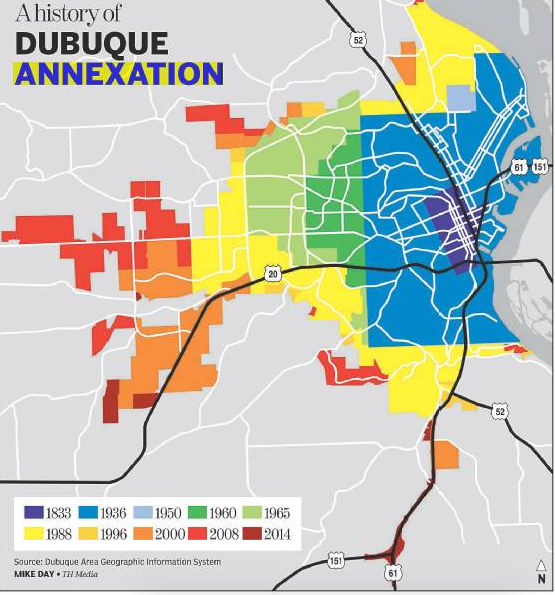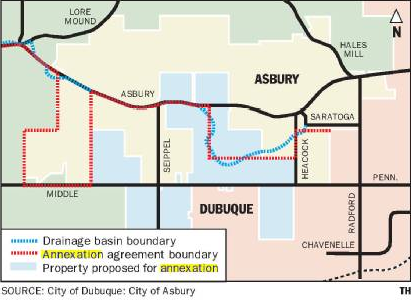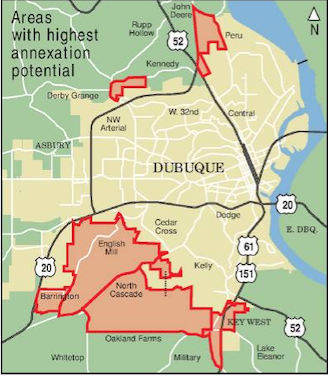Encyclopedia Dubuque
"Encyclopedia Dubuque is the online authority for all things Dubuque, written by the people who know the city best.”
Marshall Cohen—researcher and producer, CNN
Affiliated with the Local History Network of the State Historical Society of Iowa, and the Iowa Museum Association.
ANNEXATION
Being researched
ANNEXATION. According to most scholars, the LOUISIANA PURCHASE was the largest and most important annexation of land by the United States since the formation of the original thirteen colonies. The region, purchased from France in 1803, was an ill-defined area including all of present-day Iowa and extending from Canada to the Gulf of Mexico. It included the present state of Arkansas; portions of Colorado, the Dakotas, Kansas, Missouri, and Montana; most of Minnesota; and portions of Wyoming. Worried that he exceeded his constitutional rights, President Thomas Jefferson justified the purchase on the grounds of military need.
Locally, the City of Dubuque has used annexation to acquire land needed for city growth since efforts at restoration and renovation of historic buildings did not provide sufficient space.
In 1952, a tract of land containing 1,200 acres was added to the city limits by a court order of District Judge John George CHALMERS. According to City Manager Laverne SCHILTZ the annexation boosted the city's population by 2,200 people and helped the city grow in an orderly manner. The action also resulted in Dubuque County becoming qualified for the official designation by the U. S. Census Bureau as a "metropolitan area." The designation needed one city in the county having a population of at least 50,000. The annexed area extended roughly from West 32nd (Millville Road) to Highway 20 and included Lennox Addition, Highland Park Subdivision, Park Hill area ad the surrounding territory. The only objection was raised by William and Ethel Jenni who claimed their property was too rough and not suitable for city lots. The city then excluded their property. The city was immediately prepared to provide police and fire protection and within days to propose a rubbish collection schedule. Water, sewage, and street repairs would be provided when the property owners petitioned for them. (1)
In 1958 residents of Center Grove who vigorously opposed annexation formed the Center Grove Annexation Protest Committee. Their work led to rejection of the proposal in the November election with eight of the 16 city precincts, all in polling places north of 13th Street, voting "no." (2)
A special meeting of the Dubuque City Council on February 29, 1960 was scheduled to decide whether to begin another annexation program for the area. The issue was raised when the council officially received a Chamber of Commerce Resolution pledging support for any annexation program calling it "necessary for proper long range planning for expansion and growth of the city." An important factor in annexation was whether to extend sewer and water lines outside the city limits. Requests for both had come to the council from people willing to pay for constructing the lines and who supported annexation. One such request had come from Hillcrest Builders, Inc. which planned a development along Pennsylvania Avenue. (3)
Supporters of annexation living in Center Grove formed the Center Grove Committee for Annexation prior to the February 29th meeting. It was the organization's plan to present to the Dubuque City Council a letter listing advantages of annexation. The organization was also attempting to counter a strongly worded leaflet opposing annexation. (4) Opposition also came from Key West residents. The total amount of land involved in the potential annexation was 6.5 square miles. (5)
The City Council in April, 1960 adopted a "go-slow" approach to annexation. Considerations included the costs of extending sewer and water facilities and fire protection. Mayor Peter Joseph TAKOS suggested the annexation of a region between Highway 20 on the south and W. 32nd with the west line near the Village of Asbury. Other councilmen tended to support the idea--annexation to the west only. (6) In making his suggestion, Takos added:
It behooves us to re-evaluate our position in the state because
if a city doesn't show a substantial gain (in population), it
shows a stunting of the business and industry.
If the town's going to get off its cork, it's going to have to
reevaluation its position at present. The greatest reason for
the position that we're in is because we haven't kept up with
the temp of industrial attraction of the other towns. (7)
A Supreme Court decision in 1961 offered local elected leaders encouragement. The court ruled unanimously on the validity of the Iowa annexation law. The decision rose from a case in Cedar Rapids where a group of property owners claimed the law was illegal because the Legislature that passed the law had not reapportioned itself. Mayor Takos used the decision to question those who automatically react negatively to the suggestion of annexation. (8)
If someone says he is dead against annexation, I would examine
his motives carefully because the experience of hundreds of
cities reveals the benefits of proper annexation--better planning,
more orderly development and a great savings to the tax-payer.
Annexation opponents were given a surprise boost when URBAN RENEWAL became a focus of city government. Annexation opponents declared "clean up your own backyard before you make it bigger." Planning Commissioner Raymond Bergquist remarked that urban renewal would show what "we intend to do in our yard." He remarked that annexation would aid in relocating families that would be displaced by clearance of sub-standard housing areas in the city. (9)
Faced with a broad plan for "community improvement," City Manager Gilbert D. CHAVENELLE suggested in April, 1961 that annexation be placed on hold until current studies were completed. A tentative election would be held in the fall. (10)
In November, 1961 a 60-acre tract of land northwest of the Old Timers-Asbury road intersection was added to the City of Dubuque. The annexation followed a petition filed by seven property owners. The parcel did not include the Mulgrew service station, Farm Bureau office, OLD TIMERS SUPPER CLUB and some residences on the west side of Old Timers Road, the city boundary. The area was intended as a subdivision. Although some properties bordering the road did not come into the city, the annexed area was joined to Dubuque by a 255 foot wide strip of Old Timers Road which remained a county road. (11) In November, 1961 among the accomplishments of the council over the previous two years, Peter Takos pointed to over 230 acres of land being annexed to the city. (12)
There is no doubt of the feelings toward annexation by the editorial board of the Telegraph-Herald. In an editorial entitled "Let's Growl" the editors suggested that housing development, municipal service extensions, urban renewal, downtown renovations, parking expansion and possibly the most important--a dynamic annexation program--was within the range of accomplishment. The paper suggested Dubuque was slower than most Iowa cities to authorize extension of city limits to accommodate suburban growth. Among the excuses were our hilly terrain and the feeling the city should not encroach on those who chose to live on the outside of town. "Expansion generates civic enthusiasm and enterprise. A growing city naturally attracts new residents and industries." (13)
On December 15, 1964, Dubuque voters overwhelmingly approved by an 8-1 majority the annexation of approximately two square miles to the city. The area extended west from the city limits just north of 32nd Street to about half a mile east of Asbury. It went south to Pennsylvania Avenue, east to the west edge of the Key Knolls subdivision, and then south to Highway 20, and again east. (14)
In 1969 voters clearly rejected annexation proposed by city officials by a vote of 10,919 to 5,354. Opponents had included officials of the JOHN DEERE DUBUQUE WORKS and the North Dubuque Annexation Protest Group. Officials of EXPAND and the city were discouraged that they had been unable to convince local taxpayers that annexation would provide tax relief. Officials had feared a substantial portion of the property owners were attempting to annex to Sageville, an incorporated by non-taxing municipality. EXPAND's campaign had centered on the annexation providing tax relief and the development of a rich suburb close to the financially challenged city. (15)
Annexation led to a split vote by the Dubuque City Council in July, 1973 as it authorized the planning and zoning commission to petition the county for voluntary annexation of parts of three roads to the north of the city limits. The annexation would clear the way for a voluntary annexation of eleven acres--an action which had the support of the planning commission. To make the annexation of the property legal--contiguous to the city--the county had to permit the city to claim portions of Hogrefe and Burden avenues and Sheridan Road. The planning commission received permission to pursue that with the county by a 3-2 vote. (16)
The council, however, was split on the general question of annexation. Council Wayne MOLDENHAUER asked that the annexation be postponed until the planning commission presented an overall plan. Moldenhauer believed the city should follow the Gruen report which supported the city picking up small parcels of land in all directions rather than large tracts reaching into the county. Proponents of the opportunity presented claimed that the land would undoubtedly be part of any long-range annexation plan. Adding to the tax base of the city would present a stronger case for further "rounding" of the city boundaries. Mayor Joseph BITTER joined Walter A. PREGLER and Allan THOMS in authorizing the petition, but added his opinion that the city's annexation policy was little more than "getting every piece of property we can get." Councilman C. Robert JUSTMANN added,"How much longer are we going to continue this inexorable march westward?" (17)
In December, 1973 city officials announced they planned to take to the voters a plan to annex nearly seven square miles, 40% of the city's present size, at an election in the spring or summer of 1974. Key West and Rockdale to the south, the Cedar Cross Road area to the southwest, Stone Hill area and Highway 52 between 32nd Street and the South John Deere Road would be included. FLEXSTEEL INDUSTRIES, INC. would come in, but the John Deere Dubuque Works would not. This would be the first annexation vote since the rejection in 1969 and if approved would be the first successful involuntary proposition since 1,380 acres were added to the city in 1964. (18)
In 1998 an annexation study reviewed fourteen areas. A voluntary annexation request for all or parts of a studied area could be made if owners of at least 80% of the property targeted for annexation would be needed.
In 2003 City Manager Michael VAN MILLIGEN suggested that the City of Dubuque could add at least $1 million to its valuation if it annexed 700 acres between Asbury's city limits and Middle, Seippel, Asbury, Chavenelle and Heacock Roads. In preparing for growth of its western border, Dubuque had constructed a $1.38 million water tank. (19)
The annexation was challenged by the City of Asbury which challenged Dubuque's methods in obtaining property owner approval. In the fall of 2006 the Iowa Supreme Court overturned a lower court ruling, sided with Dubuque, and approved of the annexation. (20) Although some land owners opposed the change, state law did not allow "islands" of non-annexed property. (21) In addition, four-fifths of the members of the City Development Board, an entity within the Iowa Economic Development Growth Management division, was required to approve an 80/20 annexation. A 100% voluntary annexation only required a majority vote of the five-member board. (22) The annexation had been approved by 93% of the property owners. (23)
In 2006 an annexation study, the first since 1998 was commissioned at a cost of $24,500 from Bob Veenstra, of Veenstra and Kinim, Inc. of West Des Moines. The study did not make actual recommendations. It looked an where areas ranked to determine which appeared to be ore favorable or less favorable for consideration. The study involved 23,000 acres of land primarily south and west of the city limits. The study divided the land into 23 speculative areas and graded area based on level of development, costs to provide city services and location. To the north, the study involved Barony Woods and Deer Valley subdivisions as well as an area bracketed by Peru and John Deere roads and south of the JOHN DEERE DUBUQUE WORKS. To the south and southwest, the study focused on four sections from Key West to Barrington Lakes and north of Oakland Farms Road. (24)
---
Source:
1. "Annexation Given Final OK," Telegraph-Herald, February 8, 1952, p. 1
2. "Annexation, Jail Issue Out, Telegraph-Herald, November 5, 1958, p. 1
3. Ibid.
4. "Center Grove Group Forms for Annexation," Telegraph-Herald, February 29, 1960, p. 1
5. Shively, Neil, "Center Grove, Key West Groups Oppose Annexation," Telegraph-Herald, March 1, 1960 p. !
6. "City Delays Annexation Action Again," Telegraph-Herald, April 19, 1960, p. 3
7. "Our Population Gain," (editorial), Telegraph Herald, May 28, 1960, p. 6
8. Shively, Neil, "Mayor Asks Realistic Approach to Problem," Telegraph-Herald, March 12, 1961, p. 15
9. Shively, Niel, "Officials Agree on Dubuque Facelift," Telegraph-Herald, May 11, 1961, p. 1A
10. "Broad City Plan Told," Telegraph-Herald, April 17, 1961, p. 11
11. "City Annexes 60-Acre Tract," Telegraph-Herald, November 24, 1961, p. 1
12. 'Giant Strides' Made by City, Takos Claims," Telegraph-Herald, October 31, 1961, p. 2
13. "Let's Growl," Telegraph-Herald, January 2, 1962, p. 3
14. "Dubuque Annexation Wins 8-1 Majority," Telegraph-Herald, December 16, 1964, p. 1
15. Bulkley, John, "Emphatic 'No' Given Proposal to Annex," Telegraph-Herald, October 7, 1969, p. 1
16. "Divergent Views on Annexation Policy Aired," Telegraph-Herald, July 31, 1973, p. 7
17. Ibid.
18. Fyten, David, "Annexation Plan May Go to Voters Next Year," Telegraph Herald, December 6, 1973, p. 10
19. Coyle, Erin, "Official: Add Acres, Dollars," Telegraph Herald, August 25, 2003, p. 1A
20. Bragg, Mary Rae,"Court OKs Annexation," Telegraph Herald, October 26, 2008, p. 1A
21. Kundert, Rob, "City of Dubuque Eyes Elbow Room," Telegraph Herald, December 13, 2006, p. 1A
22. "Peosta Passes on Annexation of Thunder Ridge," Telegraph Herald, July 22, 2015, p. 5
23. Kundert, p. 2A
24. Ibid.




